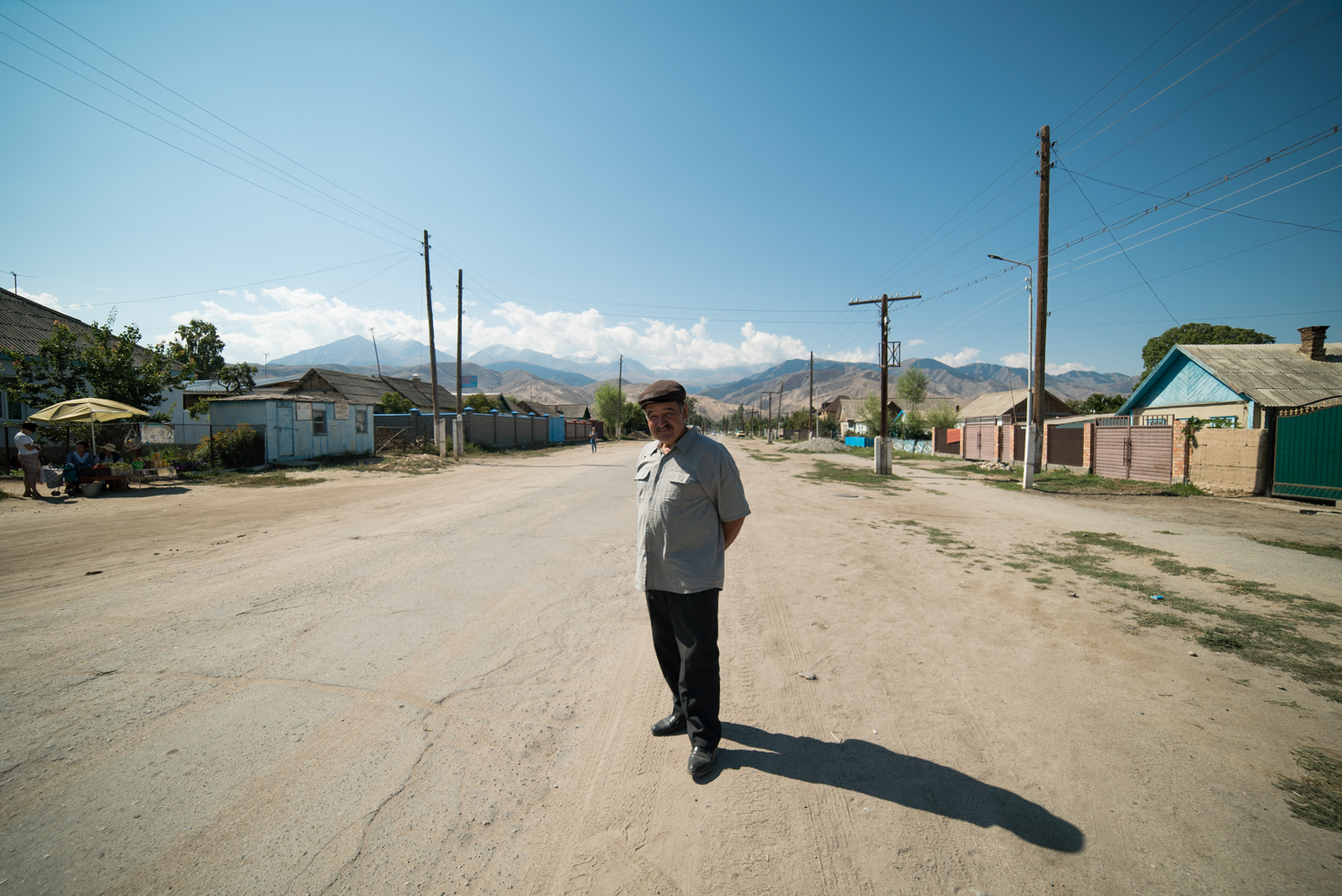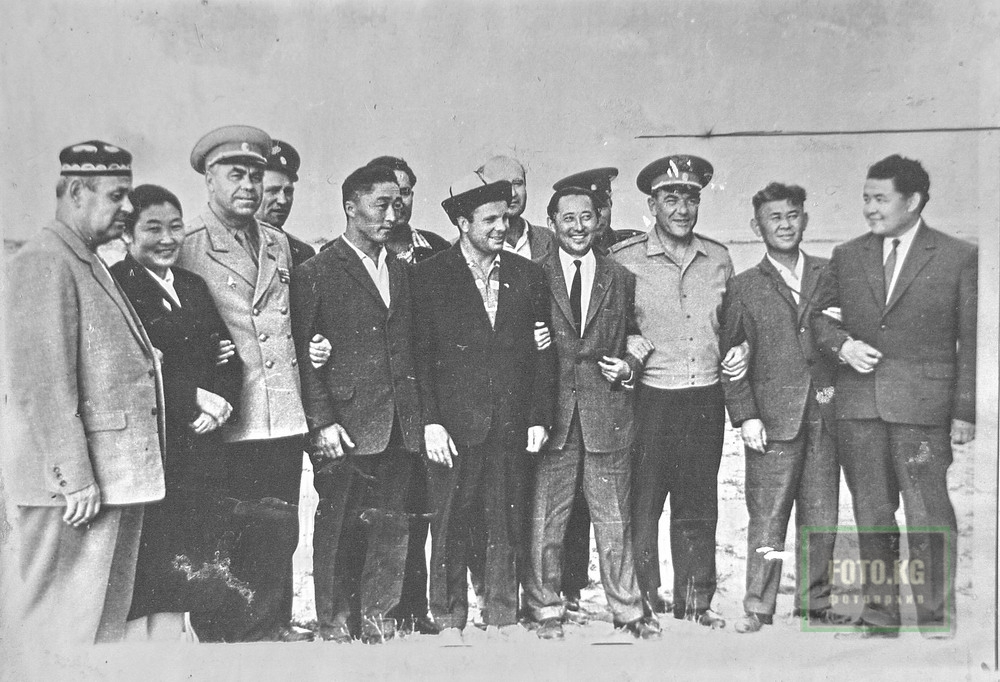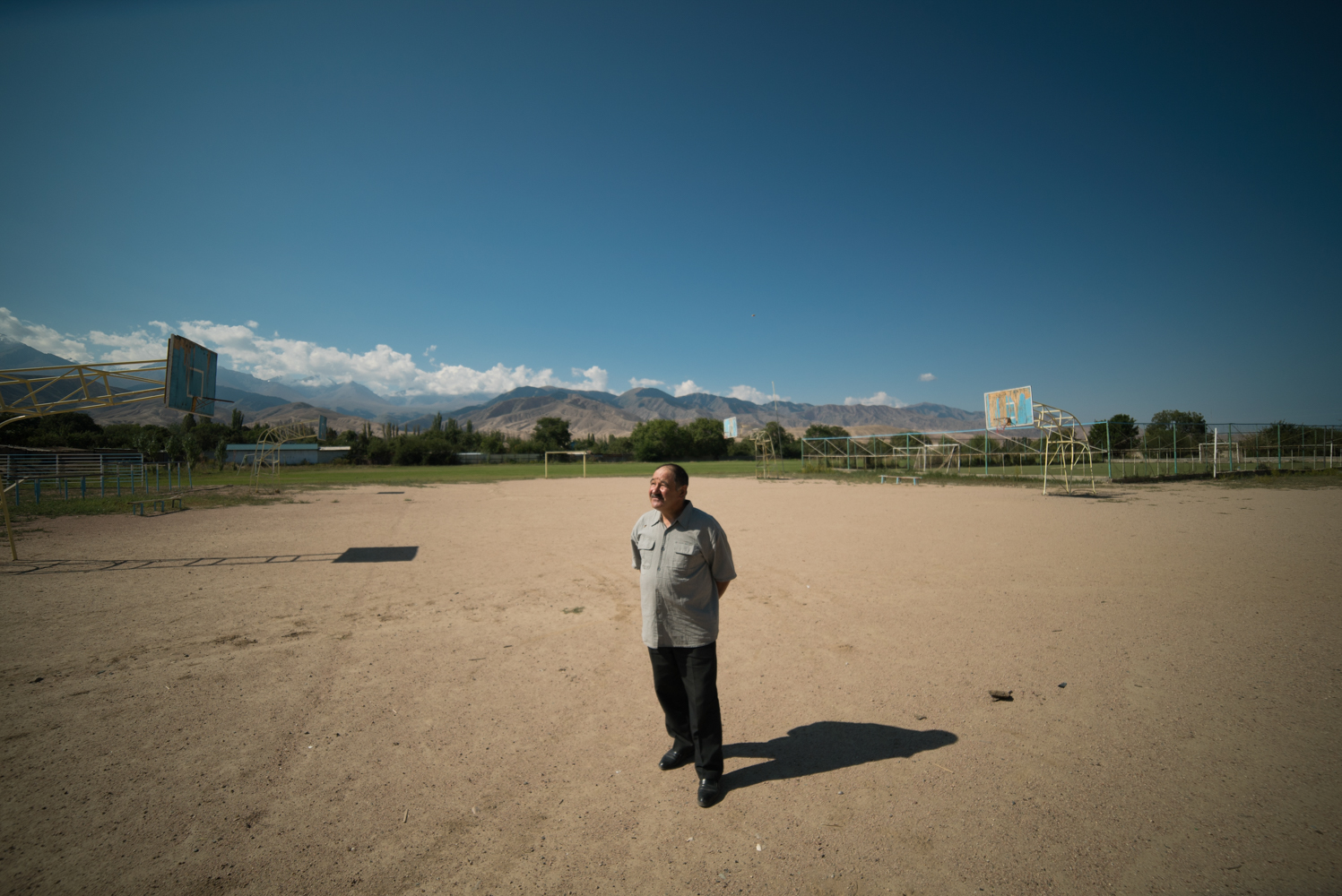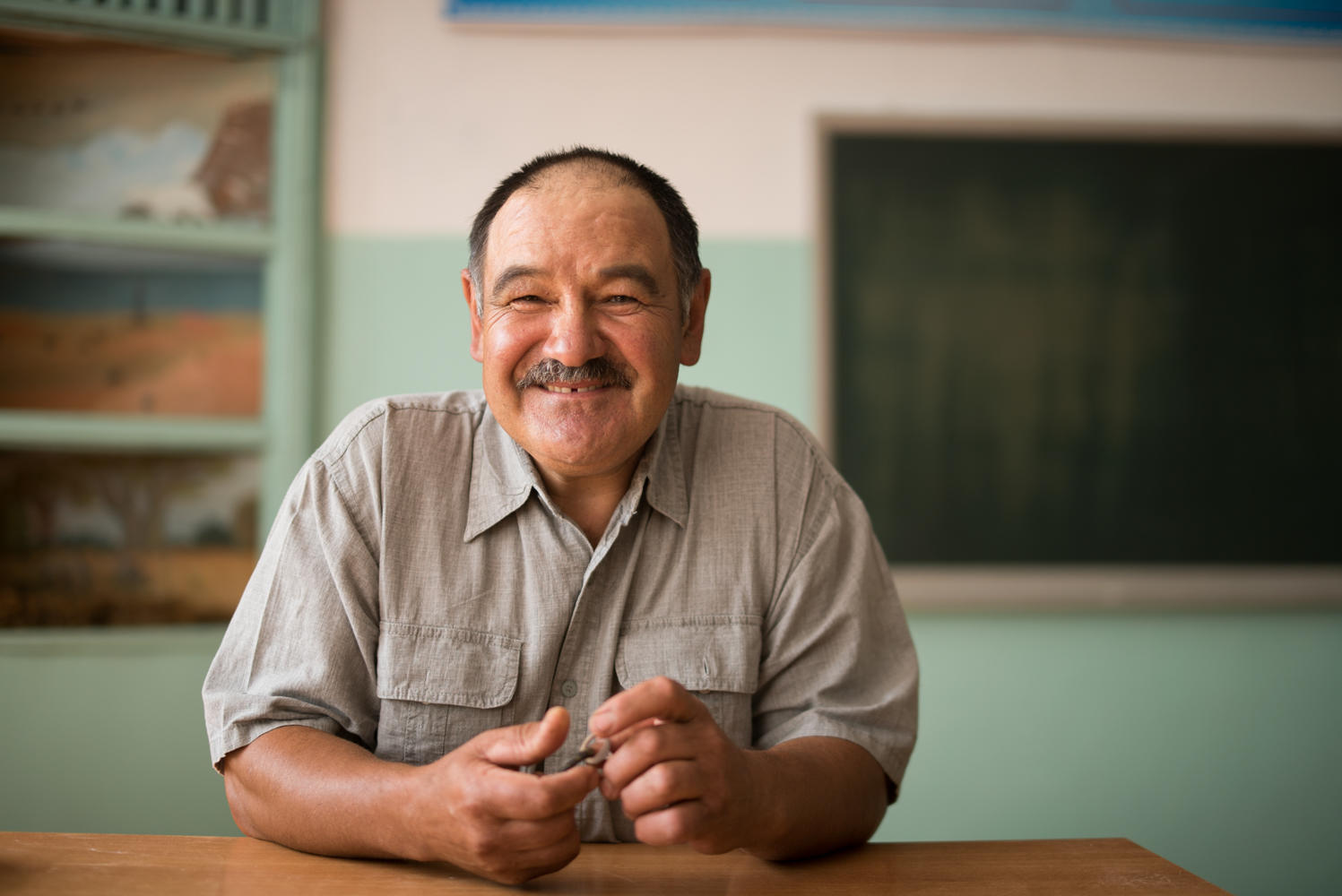THE TWENTIETH CENTURY
Nearby our village there are ancient prayer stones inscribed by Tibetan monks centuries ago. Such exquisite and tremendous workmanship was put into creating these stones! That place is called Tamga Tash. It’s from these stones that our village got its name — Tamga.
My grandparents were born in Almaty1 — a city that used to be named Verny back then. Later, they moved from Verny to Ananyevo2 village, not far from Cholpon-Ata. In 1916 there was an uprising in our neck of the woods that led to a terrible massacre3. That year my grandma was all alone — her husband left for the front, to fight the Germans in World War I. Kyrgyz people saved my family. They came to my grandmother and said, “Pack your things and escape right away. Tomorrow militias will arrive to slaughter everyone here. Run!” Grandma took the kids and, with only the clothes on their backs, they ran away. It was a horrible year; many innocent people died.
After their salvation in 1916, grandma and her kids started a new life in Karakol. Later my granddad got back from World War I. He built a wooden log-house. Karakol was where my father was born. In 1922, grandpa dismantled that house, marked each beam, stowed them on a barge, and shipped to Tamga. Here he let the beams dry, and rebuilt the house. We still live in this house; grandpa was really good at building. So that’s how our house crossed Issyk-Kul lake.
If they hadn’t given away their cow at that time, the whole family would have been exiled to Siberia or executed by firing squad. Not all the kids survived those events…
During the famine years4, our family survived because they had a cow. Then collectivization started and people with rifles came for their only cow. Grandma, with the eight kids she had at that time, stood up and said, “This cow is our breadwinner, please, leave it to me!” Grandma wanted to save the cow and grasped at it. But my grandpa immediately understood everything and let them take the cow. If they hadn’t given away their cow at that time, the whole family would have been exiled to Siberia or executed by firing squad. Not all the kids survived those events… Those were really hard times, hungry times… But that’s alright… those who survived managed to grow into decent people. Later, two more of my father’s brothers died at the front (World War II — Å). My father was the only survivor among the men. As far as the women of our family were concerned, fate dispersed them all to different parts of the world: Bishkek, Moscow, Tashkent, Kazan…
The Tatars came to Tamga in the 1920s. Ever since then, houses here still stand in the same order: Tatar, Kyrgyz, Tatar, Kyrgyz. Here in Tamga, the population is diverse. We have Kyrgyz, Tatars, Russians, Ukrainians, Armenians and Uzbeks. A whole dozen ethnicities! That’s good. We live in harmony. In other villages, they keep arguing with each other. But it’s nice here — we don’t fight, we get on with each other really well.

Image: Timur Nusimbekov
I was born in Tamga. When I was a kid, Tamga used to be a tiny village, but then it kept growing. In 1961, the year I was born, the very first astronaut on Earth, Yuri Gagarin, visited our Tamga. Can you imagine — he flew up, became the first man in space, then landed and headed to Tamga right away. Gagarin came here in April, but I was born in July, so we never met.

Yuri Gagarin in Tamga
SCHOOL
At first, the school I went to didn’t have enough teachers. When I was in the first grade, our teacher had died and there was no replacement for her. A class with no teacher — another one comes and leaves, and another one, and another one… It all came to a point when a librarian sat with us in a classroom, and, after 45 minutes, she would say, “Ok, kids, no more lessons today — you can go now.” That’s how it used to be. And then it all fell into place when a family of teachers arrived in our village.
I remember, when I was a kid, an army general — Nikolay Lyaschenko5 — visited our village. He made a promise to the local people, “I'll build a school for you.” But the government wouldn’t allocate money for a school, so he wheedled the funds for a military hospital. Back then the whole Soviet Union was preparing for a war with China. So the construction battalions built a hospital. Lyaschenko oversaw the whole construction process and inaugurated the hospital building himself. It was really well built. As soon as he accepted the building, he gave it over for a school right away. The army general Lyaschenko kept his word. Soon it will be 50 years since our school was built. Many schools built afterwards have fallen apart already, but ours is still standing and will be standing, because it was built to last. So it goes…
%20-%203-2-2.jpg)
Never will I forget my school teachers. Never will I forget my Biology teacher. Never will I forget Olga Ivanovna, she used to teach us History and Geography — my favorite teacher… Thank God, she’s still alive, now old though…
When I studied at university, we had amazing professors. They truly loved science and the craft of teaching, and thanks to them, we fell in love with our profession too.
After graduating from university in Karakol I returned to Tamga. The principal of our school was a wonderful man — Daut Imanaliyev. He looked at me and said, “Zabirov, we’re assigning you to teach Geography and Biology, and you’ll be decorating the Geography classroom.” At first, I got a little confused with that decoration thing, but he helped me with everything — getting supplies, taking care of the classroom makeover and renovation… he would even carry all the hardware with me. That’s what kind of person he was!
THE LESSON
I don’t just remember my first class, I even remember the very first lesson I gave. And it was a nightmare! I wasn’t given a fifth or sixth grade class to start with, no — it was a senior class! I had to work with the kids that grew up with me, they were just five years younger than me. Boys tried to show off and started calling me by first name. But I told them right away, “From this day on, to you I am not Kamal, but Mr Zabirov, I am your teacher now!” Of course, I got really nervous, besides it was so hot on that day, and I was sweating both from worrying and from the heat. My shirt was soaked with sweat, and the guys were laughing and asking, “Mr Zabirov, should we bring you a towel? Or maybe a sauna broom?” But then everything went well, kids started to respect me and treat me as their teacher. I still keep in touch with many of them. Later I was a teacher for those boys and girls' kids. Now their grandchildren are in my class. So it goes…

After university I worked in the school for two years and then shaved my head and went into the army. I served outside Moscow and would often spend my days off in the city. So I know Moscow like the back of my hand. We had a very good unit commander. Anytime there is was a concert in Moscow, he’d go to the box office to buy tickets for us, soldiers.
The best time of the day when you’re in the army is evening. Because in the evening they'd pass out letters from home. Sometimes I would get 40 letters at a time. Our Commander asked me, “Zabirov, are these letters from girls?” But they were from the kids in Tamga, my students.
I got back from the army in 1985, returned to my school, and continued my work as a teacher. And I’ve been working since then. So it goes…
The very first and the most important quality that a teacher must possess is love. Love of children.
People often advise young teachers to have nerves of steel. Perhaps having nerves of steel is important indeed. But in my opinion, the very first and the most important quality that a teacher must possess is love. Love of children. If there is no love in your heart, you’re not a true teacher.
A teacher has no right to raise a hand against a child. If you beat a child once, you’ll lose his respect and trust forever, and that will be the end. A teacher has to always find a right approach to each student and seek solutions for any situation.
%20-%202-2-2.jpg)
Back in the old days, in order to test a teaching student or a young teacher, he was left alone with kids in a classroom. 45 minutes later they would open the room and check: if the kids were sitting around him — then he’s going to become a teacher, but if all the kids were sitting aside — he won’t make it. A teacher is someone who doesn’t just give knowledge, but who can win a little person’s attention, too.
A few years ago I came up with a tradition for our kids — every year on June 1 we all go trekking in the mountains. And this Summer we had a nice trip too. The sky was so blue, not a single cloud! Kids gathered on the outskirts of the village, turned the music on, started dancing, and then we started trekking. We walked up in the mountains, sang songs and played games… On our way back to the village we saw a miracle: balloons with ribbons were falling down from the sky right on us — you know, those helium balloons! Probably, someone somewhere released those balloons — maybe in Bishkek, or maybe in Almaty, I don’t know. So they were going down like that, with ribbons waving in the wind. There was a balloon for each of us, and one extra. So we let that one go, and it flew away. Mine was hanging at home for a while. See, those are the gifts the sky gives to those who go to the mountains…
TAMGA
The 90s seriously affected Tamga: the population shrank, some people left for Moscow, others to Bishkek or Kazakhstan. There were no jobs, everything closed up. In earlier times people from all over the Soviet Union would come to Tamga for vacation. But after the USSR collapsed, resorts were the last thing people thought about. All the links between the former Soviet republics were cut down, some republics even got at loggerheads, strife and stupid quarrels started. I still don’t get the reasons for that strife.
The only country we have always had good relations with — even during the hardest times — is Kazakhstan
I don’t divide people by their country or ethnicity. I like all the people who come to our Tamga. I remember boys from Uzbekistan who used to come here often. Good boys, athletes. They’d come almost every year. They had a camp next to our school. They would come here for leisure but also helped us with repairs at school, always tried to support us. You never forget those kind of people. We had so many different people visiting our village — French, American, Dutch, German… What really matters to me is not the country of origin or ethnicity, but that the person is interesting and kind.
We used to have a lot of tourists from Kazakhstan here, now there are fewer. I guess, it’s the crisis to blame — it hit us and Kazakhs too.
Now there are a lot foreigners coming: Italians, South Koreans, Americans, French. From the Netherlands and Japan, too. A lot of people from Russia. That’s good. Tourism gives people jobs, local kids start learning foreign languages.
Sometimes you go outside and notice that every other passer-by is a foreigner. You go to the Tamga Tash or some other gorge and see foreigners walking there together with locals. Now kids know how to speak their languages — they’re quick learners, you know. I saw you yesterday passing by our school with those big backpacks and thought you were foreigners too. But then we talked and I realized — that’s our people. Cause those who are from Kazakhstan are our people.

It’s good for a person to get an education and learn how to earn money in a good, honest way early on. If he doesn’t learn that, he’ll then have to go to Moscow or somewhere else. Best-case scenario is that he’ll end up sweeping the streets there, otherwise he’ll join some gang or start stealing. But if the person has an education, even faced with a linguistic barrier, he will start learning languages. He’ll start expressing himself in French, English, Chinese or Turkish — and that’s good. I’m always glad when I hear that somebody who used to be in my class lives a decent life and found a good job. Some of my kids found their way and a good job not only in their homeland, but abroad as well. There’s someone now working in Turkey, someone’s in South Korea, and someone is in Japan.
TASTE
Back in the old days they used to say “Middle Asia,” now they say “Central Asia,” but to me it’s all the same. We’re all the same. Even though our languages differ, we still have the same mindset and traditions.
To understand the taste of Kyrgyzstan, one must try our honey. That’s number one. Honey is our specialty because once you try Issyk-Kul honey you’ll never settle for any other type of honey. Number two is the water from our lake. The taste of our water is something! So you have to try our water. The third thing that one needs in order to truly “feel” Kyrgyzstan is our forests and the smell of its needles. These are the top three for me. Anything beyond that is personal and not to everyone’s taste, even beshparmak.
If one of local apples had fallen on Newton’s head, I doubt that he’d ever discover his Law of Universal Gravitation.
Nowadays people travel to different countries. Our people are getting used to some things, and foreigners — to other things. You can hardly surprise a foreigner with beshparmak now. Not everyone likes meat and beshparmak. Besides, there are so many vegetarians now. But we can still impress the whole world with the taste of our berries, vegetables, apricots and apples. All organic, tasty, healthy and eco-friendly. Such delicious apricots grow only here. Apples that ripen here are often very big in size. If one of local apples had fallen on Newton’s head, I doubt that he’d ever discover his Law of Universal Gravitation.

About 15 years ago, when my mom was still alive, I built a tandyr6. First, I made wooden arcs, then faced them with bricks, then a layer of goat’s overhair, then clay, and then overhair again. So, it’s multilayered — to keep the heat inside. We bake our own bread in it. My bread differs from the one sold in a grocery just as the day differs from the night.
Now I see our Tamga growing again, there are more people now. Now people come here from all over the globe. That’s good.
When I was young, I remember coming back home from Moscow. Took a plane to Bishkek, then a night bus to home. At 4 in the morning we passed the lake, the boathouse, then I got off the bus and climbed the hill nearby our village. It was the moment when the grass had just been mown and there was such a smell all around! The scent of freshly-cut grass on the one side and that of blossoming gardens on the other… and the clover field smelled so nice… and the mountains! And, of course, the freshness of our Issyk-Kul… I almost collapsed because of all those scents! I felt an urge to kiss that ground and absorb all those smells, that air. It’s so wonderful — the smell of home land.
My grandmother lived a very hard life but, despite that, she was one of the kindest people in our region. Sometimes, she would notice a stranger passing by our little house and tell him, “Hey, come inside, have some tea, eat something!” We would then tell her, “Grandma, you don’t even know him!” And she’d answer to that, “If I don’t feed this person and don’t treat him with a cup of tea, then who will?” That’s kind of person my grandmother was…
NOTES
1 / Almaty — the largest city of Republic of Kazakhstan, the first capital of independent Kazakhstan. During the Bronze Age this area was one of the centers of development of the Sakas' and later, the Usuns' civilizations. In the Middle Age Almatu (Almaty) was one of the trade, craft and agricultural centers on the Great Silk way that had a mint, and a major camp of Turkic and Mongolian nomads. In 1854 on Almaty’s place the Zailiyskoye military fortification was founded, later renamed to Vernoye. From 1867 — Almatinskoye, from 1867 until 1921 — Verny, from 1921 — Alma-Ata in Russian and Almaty in Kazakh. Starting from 1993 the city's official name is Almaty.
2 / Ananyevo — a village on the Northern shore of Issyk-Kul lake. Named after the native of the village, Nikolay Ananyev, Hero of the Soviet Union, soldier of the Almaty regiment of the 316th (8th Guardian) Panilov’s rifle division. The division was founded in Alma-Ata (Almaty) in 1941; soldiers and officers from Kazakh SSR and Kyrgyz SSR formed the backbone of the division. Because of the outstanding military qualities and mass heroism noted by both Soviet and German militaries and historians, the division became one of the most famous units of the Soviet Army during the World War II. Panfilov’s division played a significant part in the Battle for Moscow: as the War climaxed, the division managed to stem the Wehrmacht and SS troops’s attacks on Moscow and batter several units of Hitler’s army. A significant part of the division’s soldiers and officers died while defending Moscow. Nikolay Ananyev, like many other soldiers of the Almaty regiment of the 316th division, died in the fall of 1941, while repelling the attacks by Wehrmacht’s tanks and infantry on Volokolamsk.

Nikolay Ananyev
3 / “Central Asian revolt of 1916,” “Rebellion in Turkestan” — an armed anti-colonial revolt of the Central Asian nations against the central government of the Russian Empire; the largest humanitarian disaster of 20th century in the region. Suppression of the revolt was associated with systematic war crimes by Czarist troops and mass casualties among civilians of Kazakhstan, Kyrgyzstan, Tajikistan, Turkmenistan and Uzbekistan. In a number of regions, the punitive tactics included the complete annihilation of the local population, including women, old people, and children. The targeting and annihilation of civilians led to the tragedy of “Chon Urkun” (“The Great Exodus”), when, saving themselves from the punitive troops, hundreds of thousands of Kazakhs and Kyrgyzs were forced to flee to Western China. The Russian Imperial Duma commission under the command of A. Kerensky, dispatched to the region in 1916, identified numerous cases of war crimes and mass casualties among the civilian population, as well as the use of ethnic cleansing in a number of locations. The commission concluded that the Russian Empire’s ruling elite as well as a number of military and police authorities that participated in the punitive actions were responsible for the tragedy. The death toll estimates of the 1916 tragedy vary from 100 thousand to 400 thousand. Beginning in 2016, the victims of the 1916 events are commemorated on a national level in the Kyrgyz Republic. Kyrgyzstan became the first and currently the only republic in Central Asia that publicly commemorates the victims of the 1916 tragedy.
4 / The famine of 1931−1933 (“Asharshylyk,” “Uly Jut,” “Holodomor,” “Goloschyokin's famine”) — one of the major yet under-reported tragedies in the modern history. As a result of policy of collectivization, seizure of the major sources of livelihood and repressions against peasants, nomadic cattle herders and the “kulaks” led by Bolsheviks under the command of Joseph Stalin, a number of regions of the USSR had been spanned by massive famine. The greatest level of casualties were in Kazakhstan and Ukraine, the famine was also spread in some areas in the republics of Central Asia, Siberia, Ural, Caucasus and the Volga region. Number of victims of the famine in Kazakhstan exceeded that of the Kazakhs who died during World War II by several times. The famine in Kazakhstan killed from 1 million to 3 million people. In the 1930s Kyrgyzstan’s population provided significant support to starving people of Kazakhstan by sending food and accepting refugees. In 1930s Kyrgyzstan accepted over 100 thousand starving refugees from Kazakhstan and saved dozens of thousands of people from death.

5 / Lyaschenko Nikolay (1910−2000) — Soviet commander, army general, Hero of the Soviet Union, holder of the “Manas order” (Kyrgyz Republic), the Legion of Merit award (USA), the Order of the Cross of Grunwald (Poland) and many other awards. During his childhood years lived in Kyrgyz SSR (Karakol village). Fought nazis and fascists starting from 1937 during the civil war in Spain. Starting from 1941, as a commander of a regiment and later — a division, fought nazis on the territories of USSR, Poland and Germany. Lyaschenko’s division participated in breaching of the Siege of Leningrad and liberation of Ropsha, Gatchina, Pärnu, Osterode, Gniew, Starogard, Gdańsk, Swinoujscie and other cities. In the battles Lyaschenko displayed not only his military talent, but also a personal courage, had been injured several times. After the war, in order to come back to and to serve in Central Asia, Lyaschenko turned down the proposals to become a commander of the Kiev military district and a commander of the Moscow military post.
Starting in 1965 Lyaschenko served as the commander of the Turkestan military district troops, from August 1969 he was the commander of the Central Asian military district troops. In 1973 the troops of the Central Asian military district, under the command of Lyaschenko, in cooperation with the municipal, labor and rescue services under the command of Dinmukhamed Kunayev, actively participated in the construction of the Medeu dam. The dam saved the city and residents of Alma-Ata from the severe mudflow and natural disaster in July 1973.
6 / Tandyr — traditional clay-made direct heat oven. The tandyr technology is wide-spread in Central Asia, Caucasus, Middle East, Latin America, the Balcans and other regions of the world. Used for baking bread and various dishes, also has other rithual and medical uses.

